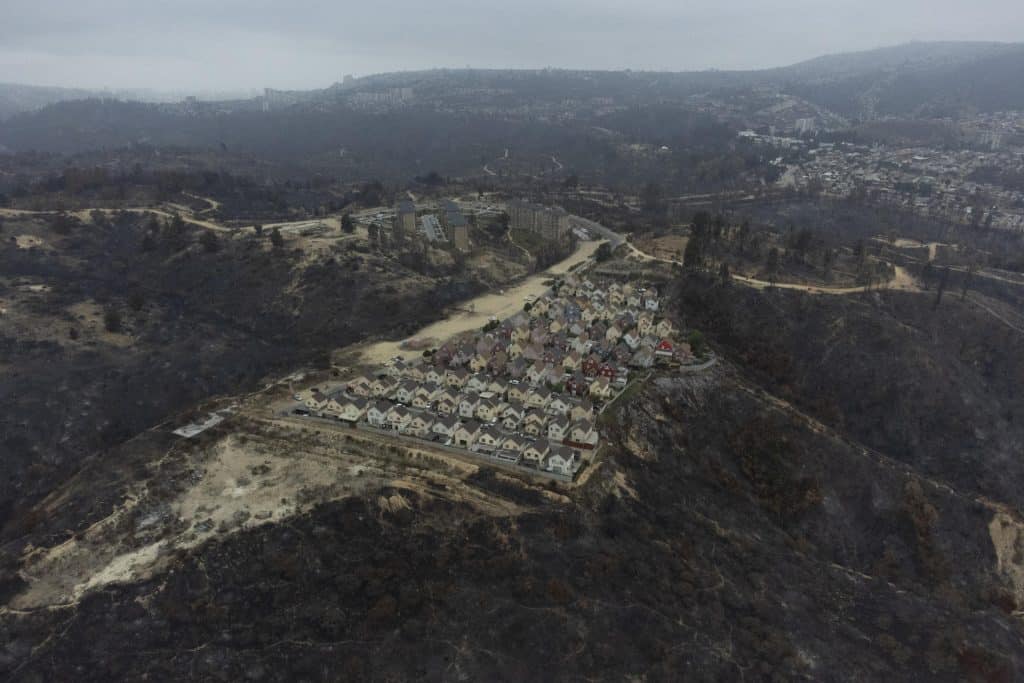19 de febrero 2024

Children of Exile: The Births “Sowing Hope” in the Camp of Nicaraguan Farmers

PUBLICIDAD 1M
PUBLICIDAD 4D
PUBLICIDAD 5D
The flames did not touch any of the houses, and all its inhabitants managed to evacuate on time from the most voracious fire in Chile

Despite being surrounded by fire, amidst the voracious chain of fires that in early February claimed the lives of 132 people in the Valparaíso region, the Botania neighborhood in Chile remained intact: the flames did not touch any of the houses, and all its inhabitants managed to evacuate on time.
It is a miracle that actually hides a pioneering neighborhood prevention program with worldwide projection.
Seen from the air, the neighborhood, a set of approximately 70 houses of multiple colors on the border between Viña del Mar and Quilpué, looks like an island amidst charred land and hills blackened by ash, burnt trees that days after the fire had extinguished still fill the air with a lingering residual odor.

On the ground, the neighbors told EFE that what many consider a miracle is the mature fruit of intense training and cleaning sessions, of rational management of vegetation in the territory, and above all, of the commitment of a cohesive community with clear roles in a model that can be applied to the rest of Chile and exported to the world.
Equipped with axes, rakes, hoes, and backpacks with a capacity of 18 liters of water, in addition to tanks located in strategic points with a capacity of 3,500 liters, the neighbors of Canal Chacao, the population of Botania and one of the most affected by fires, tried to resist.
Tools that are part of a kit provided to the community within the framework of a program financed by the US organization USAID along with the National Forestry Corporation and Caritas Chile, explained Rodrigo Vargas, coordinator of the program in Botania.
The same kit reached the 16 communities of Chile that are under this program, along with other resources that each community obtained “depending on its reality, giving the project an orientation according to the conditions,” he adds.
“We have monitoring, which we couldn’t connect this time before the emergency this time, a community alarm, prevention with fieldwork such as clearing, and communication and information delivery,” Vargas points out.
“We seek to create a unified criterion to care for each house and the environment, move trees away from roofs, clean gutters, not have combustible material in the yards, which is fundamental. If the gas cylinder is not protected, it’s over. Botania, in particular, has always been managed by its residents,” he noted.

El barrio de Botania quedó intacto: las llamas no tocaron ninguna de las casas. EFE/ Adriana Thomasa
Vargas insists that “the program stimulates peoples’ knowledge in these subjects and their connection with the authority based on coordinated and legal community work, because it’s not about arriving and managing species protected by law, among other things.” “The main thing was the strength of our community networks, working together, and having a sense of belonging.”
For this, you need to be connected even if the telecommunications fail, as happened on that fateful Friday: equipped with walkie-talkies, they shared information about the progress of the flames that at that time were already consuming much of the Viña del Mar hills surrounding them.
“No one imagined that something like this would happen,” Estrella Barrios, a member of the neighborhood coordination explained to EFE before emphasizing that the resources exist, but “neighbors need to get involved.”
This lack of participation has a concrete expression: 250 houses in Canal Chacao – out of a total of just over 1,000 – were razed by the fire, almost all bordering on private land where owners resisted vegetation pruning.
A Replicable Model
“We are looking to expand this methodology throughout the country, although there are some considerations that must be taken into account: it must be an organized community with leaders who can manage the enthusiasm and participation of its members,” explained the national head of Prevention and Mitigation of Conaf, Rolando Pardo.
“Generally, there are several workshops where information and technical tools are provided. Women are a very important actor. We must also involve the elderly, who sometimes have difficulties, as well as children and adolescents,” he added.

EFE/ Adriana Thomasa
In the same line, Catherine Mella, in charge of the Area of Environment, Risk Management, and Emergencies of Caritas Chile, highlighted that this effort “connected the most vulnerable sectors to fires with civil society organizations, universities, and local government, reducing the risk in various sectors of the community.”
“An emergency plan was designed that allowed acting promptly during the fires, in an organized manner helping their neighbors evacuate, actions that saved lives, property, and also part of the ecosystem,” she concluded.
This article was published in Spanish in Confidencial and translated by Havana Times. To get the most relevant news from our English coverage delivered straight to your inbox, subscribe to The Dispatch.
PUBLICIDAD 3M
Agencia de noticias internacional con sede en Madrid, España. Fundada en Burgos durante la guerra civil española en enero de 1939.
PUBLICIDAD 3D